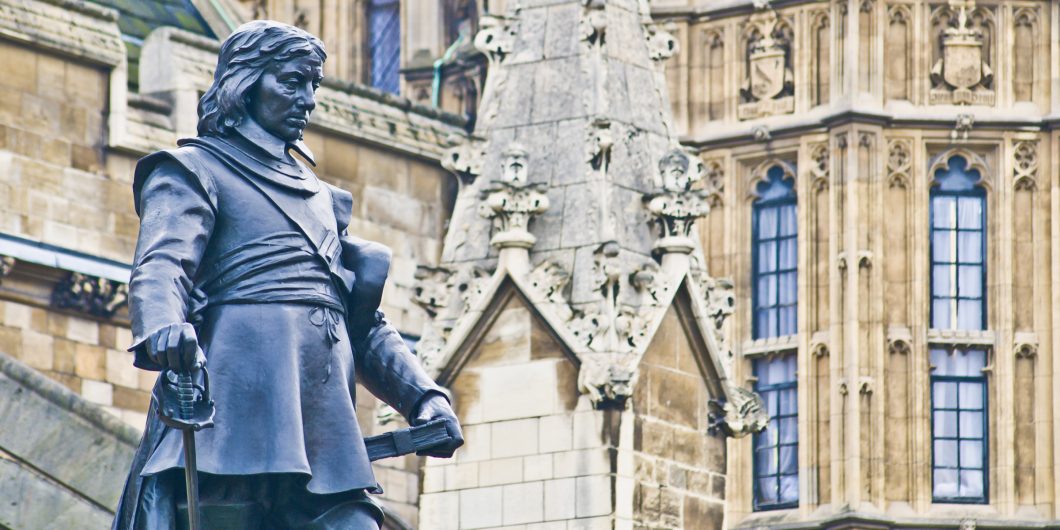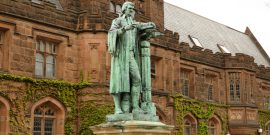Cromwell’s Revolution
After a revolutionary war against a tyrannical king, a commonwealth is proclaimed. To preserve the rule of law in the absence of a traditional hierarchy, the elected representatives of the republic adopt the novel device of a written constitution. The victorious general is made head of state. In recognition of his providential role and in order to ensure continuity, the nation’s founding father is offered the crown. He turns it down.
No, this is not the story of the American Revolution, but that of its English precursor more than a century earlier. It is part of the mythology of the United States that almost everything about its foundation was unprecedented. But this is not so. The mindset of the American Founding Fathers was deeply conservative and, unlike most of their present-day successors in Congress and the White House, they were well-versed in English history. During the period sometimes known as the Interregnum, between the execution of Charles I in 1649 and the Restoration of his son Charles II in 1660, much was anticipated in thought and deed of what would later transpire in the conflict between the American colonies and George III. Both sides drew on their own interpretations of that era in what may be seen as the third act of the drama, following the English Civil War and the Glorious Revolution of 1688, in which an epic battle of ideas was fought out over almost 150 years.
The Protectorate
At the outset of the Interregnum, England declared itself a Commonwealth—a flexible term that is, of course, still in use for four US states. For four years, the constitutional future of England remained uncertain, while Oliver Cromwell wrestled with what was by now a unicameral House of Commons. Then, in 1653, Oliver Cromwell acceded to a petition from Parliament to accept the Crown. There was no question of him accepting the offer, though that possibility remained open. Instead, he chose the title of Lord Protector, thereby enabling historians to create a new name for the English polity: the Protectorate.
Paul Lay, the gifted editor of the independent monthly magazine History Today, has written a highly accessible account of Cromwell’s Protectorate. Ironically, this strange interlude—the only time in British history that England has been ruled by anyone other than a monarch—paved the way for what later became known as constitutional monarchy. It was the success of this new and flexible system of governance that ensured the survival of the British Crown when so many other European monarchies were swept away between 1789 and 1918.
As the dominant figure in the nations of Great Britain and Ireland that he had just united by force, Cromwell was aware that he would be seen as a dictator—not only by Royalists but by some who had supported the Parliamentary side in the Civil War. He was more than willing to accept limitations on his own powers, by sharing sovereignty not only with Parliament but also a new institution: the Council of State. With Cromwell’s blessing, in 1653 Parliament adopted England’s first written constitution: the Instrument of Government. It was envisaged by its author, Major General Henry Lambert, as a purified form of the “Ancient Constitution,” which was believed to date back to the Saxons and had been codified in Magna Carta and the Common Law. Because the Protectorate lasted less than a decade, and its legitimacy was retrospectively nullified after the Restoration, this experiment in popular sovereignty left few traces on the collective memory of the nation. Yet its language was prescient: “The supreme legislative authority should reside in one person, and the people assembled in Parliament.” Cromwell himself thought it enshrined “just liberty to the people of God, and the just rights of the people in these nations” of England, Scotland and Ireland. We can perhaps see in the Instrument one of the sources from which a very different document would emerge more than a century later: the US Constitution.
Lay, however, does not allow himself to be drawn into such speculation. His narrative is quite grand enough, focusing on the political, cultural, and especially religious forces in play at the time—forces that had torn the country apart—and how the warring factions sought to establish God’s kingdom in England’s green and pleasant land.
One of the conflicts that was never resolved concerned the crucial question of freedom of conscience. This pitted the Protector, whose instincts were surprisingly liberal, against the more puritanical representatives in the Commons. Cromwell (“a parliamentarian serially disappointed by parliaments,” in Lay’s apt phrase) was determined to have his way and largely succeeded in his endeavours. It was, for example, on his initiative that Jews were permitted to return to England, in the teeth of mercantile and clerical opposition, for the first time in four centuries. Addressing a judicial, ecclesiastical, and academic conference appointed by the Council of State, the Protector thundered that, because England was “the only place in the world where religion was taught in its full purity,” the readmission of the Jews would hasten the day of their conversion, and hence of Christ’s Kingdom on earth.
Cromwellian philosemitism emerged both from two distinctively English 17th-century traditions: Hebrew scholarship and a heightened national sense of millenarian destiny. This identification with ancient Israel, too, resonated with the American Founding Fathers. On both sides of the Atlantic, a new commonwealth could readily identify with a chosen people, led to their Promised Land by prophets rather than kings, invested with a mission for mankind by God Himself. For Cromwell and Washington alike, the Jews were living witnesses to the possibility of a providentially inspired declaration of independence from an arbitrary, corrupt and intolerant order.
Perilous Providence
Lay’s ingenious title, Providence Lost, rightly alludes to Paradise Lost, composed by Cromwell’s former Latin secretary during the bleak period following the Stuart Restoration. The great verse epic is, among other things, a lament by the by now blind poet for the visionary, though ultimately utopian, “free state” created by Milton’s former employer.
But Providence Lost also refers to Providence Island: a British colony off the coast of what is now Nicaragua which had been settled in 1629, as what Lay calls “the furthest outpost of Puritanism.” Though the island was lost to the Spanish in 1641, many of the entrepreneurs involved in the Providence Island Company played a part in the revolution against Charles I and his French Catholic queen. Cromwell, lauded by Milton as “our chief of men,” shared the merchant adventurers’ hopes that an “Indian expedition” would spread the godliness of the new Commonwealth across the New World—besides replenishing their coffers. The Protector was an enthusiast for what he and his colleagues called “the Western Design”: a grand scheme to seize the island of Hispaniola from Habsburg Spain. His formidable new navy could then use its natural harbour as a base from which to dominate the Caribbean. An “invincible armada” was dispatched to capture the Spanish stronghold under the command of William Penn, father of the founder of Pennsylvania. It arrived in 1655, a date that with hindsight can be seen as the zenith of the Protectorate.
The primary meaning of Providence, however, is the divine one. The Calvinist doctrine of predestination engendered among the Puritans a powerful sense of confidence in their own providential purpose: they could and did justify dangerous or dubious deeds by claiming to be the instruments of God’s will. Cromwell attributed his extraordinary sequence of victories—not only routing the Royalist generals, battle-hardened in the Thirty Years’ War, but conquering Scotland and Ireland, which had defied successive English monarchs for centuries—entirely to Providence. His New Model Army were the elect in uniform, saints on the march. The downside of this doctrine was that military failure implied rejection by the Almighty.
The Glorious Revolution, as it was called by Protestants, ended half a century of instability and inaugurated a political and religious settlement that proved to be permanent.
And so when the Western Design was scuppered by poor leadership and tough resistance by the Spaniards, there was no escaping the conclusion that God was against them. “Divine providence had been lost; it must be regained,” Lay comments. A chastened Cromwell went into a kind of mourning; he felt his age and the cares of office weighed upon him. Yet he accepted divine justice with humility: “We have provoked the Lord, and it is good for us to know and be abased for the same.” Acutely, Lay compares the anxiety and paranoia, the shame and vindictiveness that social media generate for the “woke” today with Puritan pietism under a ubiquitous Creator. “But one can opt out of social media, however addictive,” he observes. “There was no such option in the world God had created, nor in the next.”
There was some consolation for the saints: though Hispaniola had proved impregnable, the retreating fleet had captured Jamaica. This still largely barren island, successfully defended against the Spanish, would prove to be the cornerstone of a new West Indian empire, based on sugar and slavery. The army had failed; not so the navy. During the Protectorate Cromwell’s naval counterpart, Admiral Robert Blake, inaugurated the rise of English sea power which would enable Britannia to rule the waves for two centuries. And it was the Royal Navy, as it would soon become, that abandoned piracy in order to police the oceans and ultimately suppress the slave trade.
A Conservative Revolution?
Alongside his focus on governance, Providence, and grand strategy, Lay devotes much of this elegantly written and accessible account to the attempts by opponents of the regime to overthrow it. John Thurloe, Cromwell’s Secretary of State and intelligence chief, called these rebels the “old malignant and the levelling” parties. The Sindercombe Plot, far less famous than that of Guy Fawkes, planned to blow up Whitehall Palace, seat of the Protector. It was betrayed and foiled only at the last minute.
The corollary to these insurgents’ maladroit machinations of gunpowder, treason, and plot was what became notorious as “the rule of the major generals.” These young, energetic evangelicals were charged with the “moral regeneration” of the nation, but though they were officers, most were not gentlemen. Their social superiors did not take kindly to being patronised and penalised by these jumped-up martinets and their even more plebeian commissioners. Those suspected of Royalist sympathies were subject to the “decimation tax,” intended to pay for the militia. Some Puritan officials really were puritanical. In Southwark, London’s red light district, Major General Pride prohibited bear-baiting, “not because it gave pain to the bears, but because it gave pleasure to the spectators,” in the memorable phrase of the Victorian historian Thomas Macaulay.
And so was born the myth of the Cromwellian police state. It was during the Protectorate that the Royalist Thomas Hobbes wrote his Leviathan in French exile. Charles Stuart’s former mathematics tutor had no compunction about advising his countrymen that “the obligation of subjects to a sovereign is understood to last as long and no longer, than the power lasteth, by which he is able to protect them.” As Lay observes: “For the cold-eyed Hobbes, the pedigree of the sovereign was irrelevant.” While Cromwell’s Leviathan protected law and order, albeit by draconian methods, most people obeyed. Legality was one thing, however; legitimacy another. And as the Protector’s fragile health declined—undermined physically by malaria from the Fens, mentally by the loss of his beloved daughter Elizabeth—it wasn’t only his handwriting that became “a shaky and uncertain scrawl.” So, too, did the sovereignty he had exercised in the name of God and the English people.
The Protectorate barely outlasted its human creator. Cromwell’s death in 1658 was followed by an increasingly desperate search for a successor. His son Richard was proclaimed Protector but, lacking his father’s authority over the Army, resigned after just eight months. The Rump Parliament was recalled, as the sole remaining source of legitimacy, but was equally incapable of filling the vacuum of power. Finally, in 1660, Charles Stuart was invited by General George Monck, the Army’s commander, to return from his French exile and acclaimed as King Charles II. The Restoration of the monarchy gave the Stuart dynasty a second chance, but when James II, a Catholic, succeeded his elder brother in 1685, he tried to import absolute monarchy from his French patron, Louis XIV. By 1688 James had forfeited all trust and was forced to flee. The Glorious Revolution, as it was called by Protestants, ended half a century of instability and inaugurated a political and religious settlement that proved to be permanent.
Yet the experiment of Cromwell’s quasi-theocracy left an intellectual legacy that was never quite forgotten, least of all in the colonies beyond the Atlantic, where both bondage and freedom would be taken to much greater lengths. This brilliant book emphasizes Cromwell’s conservatism, which led him to resist both the novelties of Stuart absolutism and those of his own radicals. Like Margaret Thatcher, with whom Lay illuminatingly compares him, the Protector believed that liberty, political and religious, was embodied in the “Ancient Constitution” of his people, guided by Providence. Both the British and the Americans have reason to be grateful for that enduring insight.


